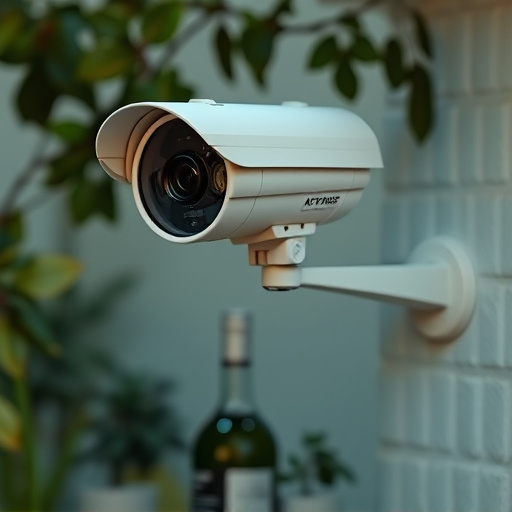When designing a mock surveillance system, select high-quality fake cameras with advanced sensors that mimic real security equipment in both look and function. Install these cameras strategically in indoor or outdoor spaces using durable brackets or adhesive, following manufacturer instructions for optimal mounting. Choose cameras with motion detection, clear image capture, and night vision capabilities to accurately simulate a fully operational surveillance setup via wired or wireless connectivity. Regularly test and optimize system performance by simulating various conditions, fine-tuning settings, and addressing false positives/negatives to ensure accurate data collection without unnecessary alerts.
“Elevate your mock surveillance system setup with our comprehensive guide, tailored for professionals and enthusiasts alike. Discover the best fake cameras with sensors available in the market, designed to mimic real security equipment seamlessly. From selection to installation and sensor configuration, we’ll walk you through each step. Learn how to ensure real-time monitoring, test, and optimize your system’s performance for maximum efficiency. Enhance your simulation accuracy using these top-tier fake cameras, ensuring a realistic and effective mock surveillance environment.”
- Choosing the Best Fake Cameras With Sensors for Your Mock Surveillance System
- Installing the Fake Cameras: A Step-by-Step Guide
- Setting Up Sensors and Connectivity: Ensuring Real-Time Monitoring
- Testing and Optimizing Your Mock Surveillance System's Performance
Choosing the Best Fake Cameras With Sensors for Your Mock Surveillance System
When designing a mock surveillance system, selecting the right fake cameras with sensors is paramount. The best fake cameras should closely mimic real security cameras in both appearance and functionality to create an authentic environment. Look for models that feature advanced sensor technologies, such as motion detection and night vision capabilities, to enhance realism. These sensors not only add credibility but also allow you to simulate various security scenarios.
Consider the specific needs of your mock surveillance setup. Different environments require different camera types. For indoor spaces, wireless cameras with IR LED night vision can be discreet and effective. Outdoor installations might benefit from weatherproof models equipped with more robust sensors. Researching and comparing different brands and models will help you choose the best fake cameras with sensors that accurately represent real security equipment, making your mock surveillance system more convincing and useful for training or testing purposes.
Installing the Fake Cameras: A Step-by-Step Guide
Installing the best fake cameras with sensors is a straightforward process that can significantly enhance home security or serve as a deterrant in a commercial setting. Begin by carefully selecting the locations for your mock surveillance system. Consider high-traffic areas, entry points, and any blind spots where real cameras might be missing. Ensure these areas offer clear lines of sight to maximize the visual impact of your fake cameras.
Once you’ve identified the perfect spots, it’s time to mount them securely. Most high-quality fake cameras come with sturdy brackets or adhesive backing designed to withstand various weather conditions. Follow the manufacturer’s instructions for the best results; this typically involves cleaning the surface, applying the adhesive, and allowing sufficient drying time before positioning the camera at the desired angle. Regular maintenance like reapplication of adhesive over time will ensure your fake cameras remain firmly in place.
Setting Up Sensors and Connectivity: Ensuring Real-Time Monitoring
When setting up a mock surveillance system, one of the crucial aspects is selecting and installing sensors that mimic real-time monitoring effectively. Opt for best fake cameras with sensors designed to look authentic but serve as placeholders for actual surveillance equipment. These artificial cameras should have motion detection capabilities and be capable of capturing clear images or video footage. Position them strategically at entry points, windows, and other areas requiring observation.
To ensure real-time monitoring, establish a reliable connectivity network. Wired connections offer the most stable option but may not always be feasible for every installation. Wireless options like Wi-Fi or Bluetooth can be used to transmit data from sensors to a central control unit or monitoring system. Ensure your chosen technology supports live streaming and quick response times to deliver an accurate simulation of a fully operational surveillance setup.
Testing and Optimizing Your Mock Surveillance System's Performance
After installing your mock surveillance system, it’s crucial to test and optimize its performance to ensure it functions as intended. Start by simulating various scenarios using the best fake cameras with sensors that mimic real-life situations. Test their sensitivity, angle coverage, and night vision capabilities under different lighting conditions. This step is vital for understanding how well your system detects and responds to movement.
During testing, pay close attention to false positives or negatives, ensuring smooth operation without unnecessary alerts. Adjust the system’s settings, including motion detection parameters and camera angles, to fine-tune its performance. Regular optimization ensures your mock surveillance system remains effective, providing accurate data for training and simulating diverse environments without false alarms.
Creating a convincing mock surveillance system doesn’t have to be complex. By selecting the best fake cameras with sensors, carefully installing them, setting up seamless connectivity for real-time monitoring, and fine-tuning performance, you can effectively simulate a security network without breaking the bank. This guide offers a comprehensive roadmap, ensuring you can efficiently install and optimize your mock surveillance system for any purpose.
